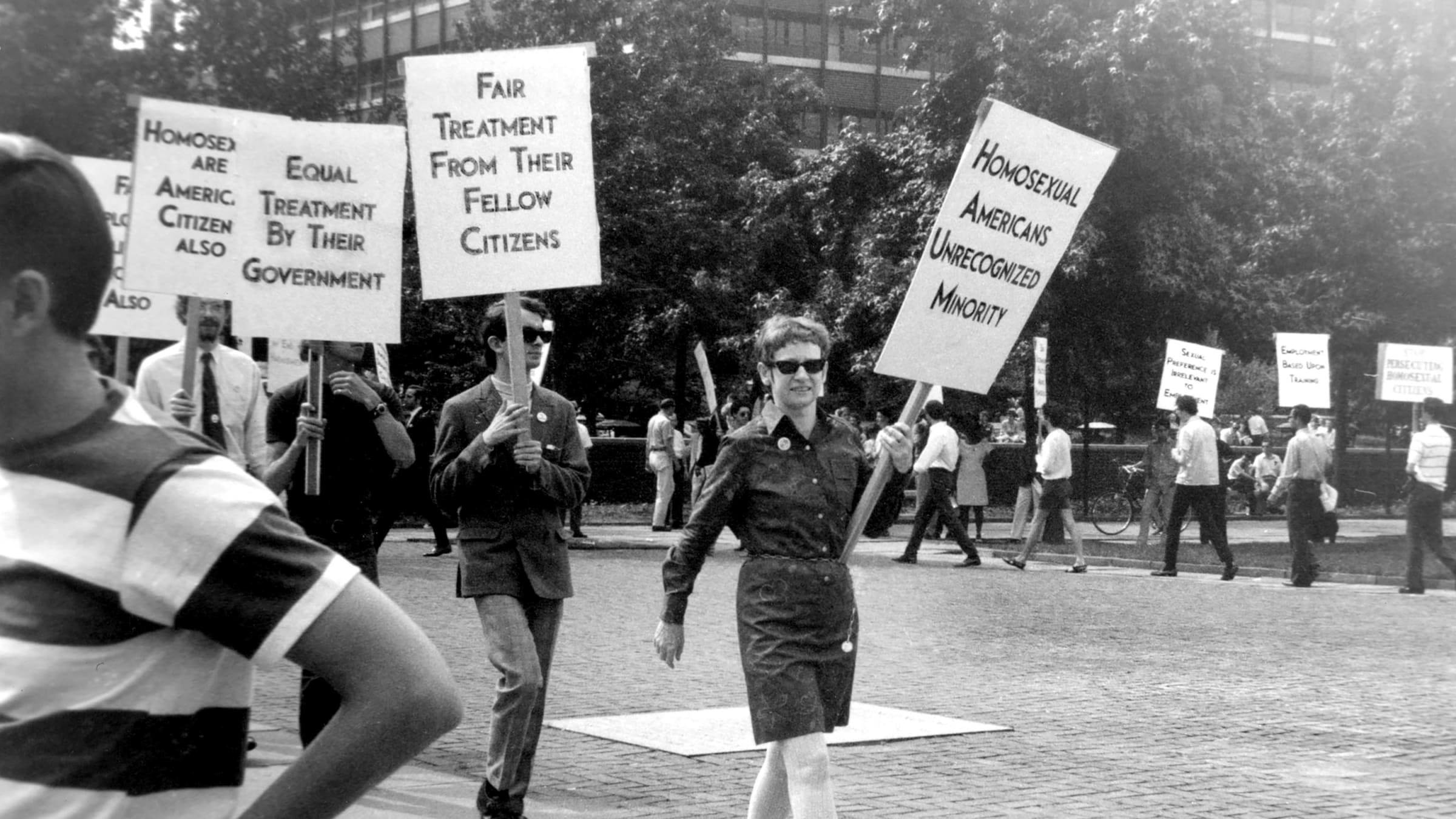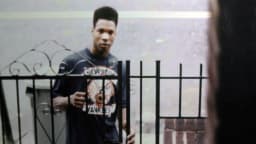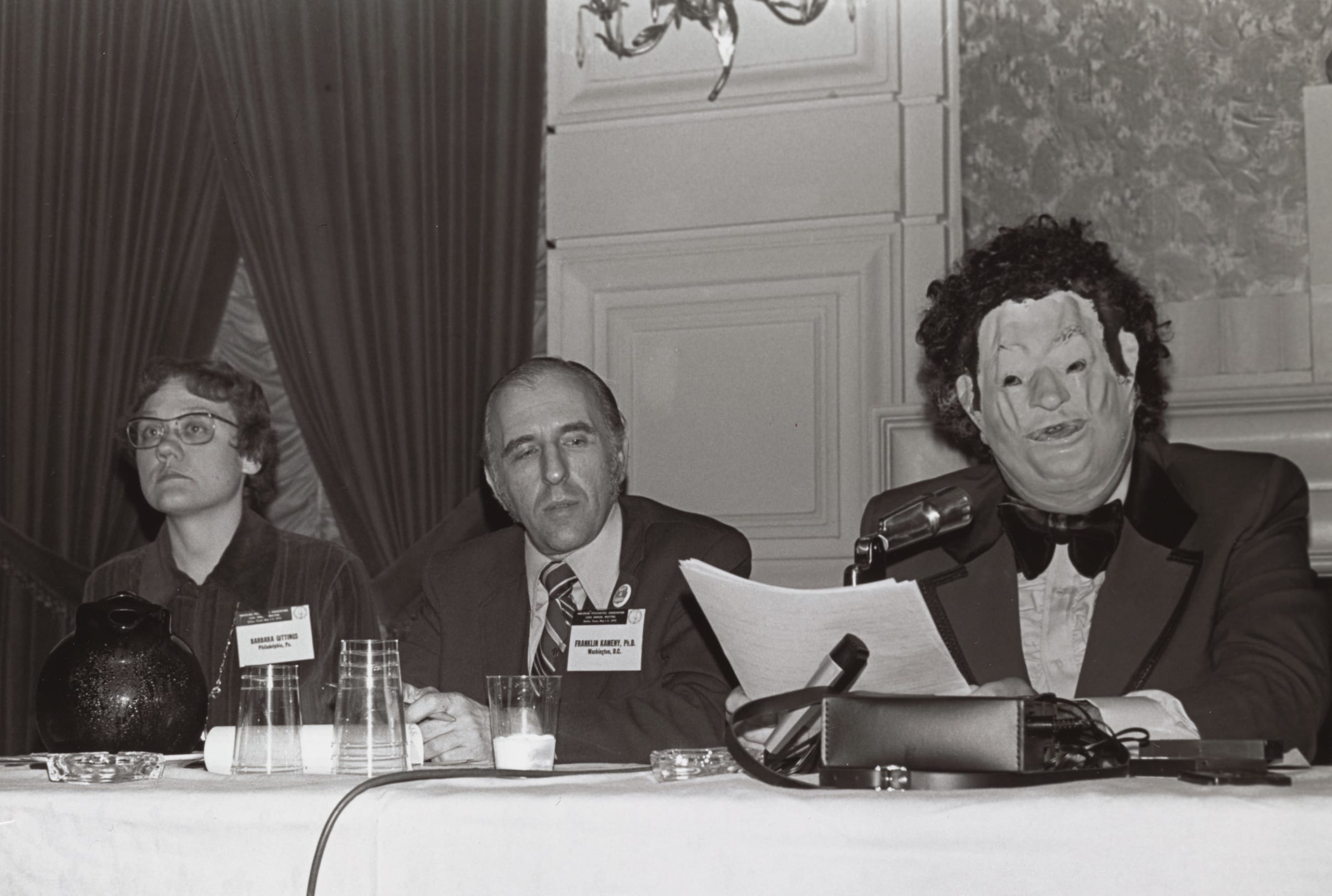
Inside the Grueling Battle to Declassify Homosexuality as a Mental Illness
HISTORY LESSON
Story Center Films
The documentary ‘CURED’ chronicles the fight to remove homosexuality from the DSM. But it overlooks the contributions of Black and brown voices—and censors some activists’ racism.
Cassie Da Costa
Entertainment Writer
Published Aug. 18, 2020 4
Any ‘Gay and Lesbian History’ college course will dive into closeted white suburban gay male representations. In fact, this group of men, sneaking around in mid-century America, have received a fair bit of Hollywood attention in recent years. There was fashion designer Tom Ford’s adaptation of Christopher Isherwood’s haunting novel A Single Man, Benedict Cumberbatch’s Oscar vehicle The Imitation Game, and Luca Guadagnino’s take on André Aciman’s Call Me by Your Name. Todd Haynes’s excellent Far From Heaven refocused the lens from a cheating closeted suburban husband to the wife’s own relationship with a Black man who works as her gardener, while Ang Lee’s Brokeback Mountain and Francis Lee’s God’s Own Country look at white male closeted culture in the context of working-class masculinity.
Patrick Sammon and Bennett Singer’s new documentary CURED looks at the white suburban gay through the lens of activism. The film chronicles the drive by lesbian and gay activists, especially Barbara Gittings and Frank Kameny, to get homosexuality removed from the Diagnostic and Statistical Manual of Mental Disorders (DSM). The story itself is a vital one to know, because it marks one of the first major drives toward a rights-oriented LGBTQ+ movement. Notably, those fighting to have homosexuality removed from the DSM were mostly middle and upper class cis white gays and lesbians—people with college educations, good jobs, perhaps even nuclear families who were fighting to live openly as gay while taking part in polite society.
The Black Teen Slaughtered by a White Mob in Brooklyn
A HISTORY OF VIOLENCE
Cassie Da Costa

The Fearless Journalist Targeted by a Murderous Dictator
THE GOOD FIGHT
Cassie Da Costa

CURED features one Black lesbian from a working-class background, Reverend Magora Kennedy, who married to avoid being sent to Utica State Hospital where she would’ve received electroshock therapy as treatment for her homosexuality. After having five children, she left her husband and began to live openly as a lesbian. She attended talk shows and panels with Gittings, the spokeswoman of the movement, and several other white lesbians. She also was present at the Stonewall Riots, and the film provides a brief glance toward those events, which were the first major spark of the gay liberation movement headed up by Black and brown trans women as well as sex workers, street kids, disabled people, and the kind of queers who were not seeking assimilation into the dominant social order, but rather the freedom to live as themselves without being harmed by the state. I don’t believe there is a simple hierarchy between these sets of desires, but they do not smoothly intersect, and have continually been at odds. For example, Larry Kramer’s bravely flagrant ACT UP movement during the HIV/AIDs epidemic spurned the status quo while the more recent gay marriage movement prioritized inclusion into an enshrined social system over, perhaps, the kind of reimagining of family that could protect homeless LGBTQ+ youth.
CURED does not differentiate gay rights from gay liberation or provide a robust context for how homophobia functioned at the time in a country also ridden with racism, classism, and ableism. And this move—to vacuum-seal the fight to remove homosexuality from the DSM—unfortunately does a disservice to the film’s message because it denies the activists involved the opportunity to make the case for why assimilation was so collectively, and not individually, crucial to them and others at the time.
Several of the psychiatrists in the American Psychiatric Association (APA) that presided over the DSM at the time were gay. In fact, there was a secret society of gay psychiatrists within the APA, some of whom were in leadership. Of course, the extreme majority of the APA were white men, and in CURED, there are merely glimpses of anyone else within the institution. As you can imagine, homophobia was not the only prejudice entrenched within psychiatry as an institution in the U.S.—blackness, specifically, was pathologized, as was being a woman; addiction was seen as a moral failing, and genuinely mentally-ill patients were often looked down upon by the doctors treating them.

John E. Fryer testifying before the American Psychiatric Association in 1972
Story Center Films
The closeted gay doctor John E. Fryer, who famously testified to the APA about homosexuality’s inclusion in the DSM while wearing a Halloween-appropriate mask disguise, wrote in his journal afterwards, “...I have identified with a force which is akin to my selfhood. I am not Black, I am not alcoholic, I am not really addicted. I am homosexual...” (emphasis mine). That second sentence is omitted from the reading Fryer’s still-living friend performs for the camera, and in an image of the journal, it is grayed out. I had to pause the documentary and take a screenshot in order to make sense of what was glossed over.
Why was it so important for Fryer to say, to himself, in his diary, that he was not Black? And in the same space of thought in which he declared he was not an alcoholic or otherwise addicted?
Why was it so important for Fryer to say, to himself, in his diary, that he was not Black? And in the same space of thought in which he declared he was not an alcoholic or otherwise addicted?
We know that, at that time (and in many ways still today), major institutions believed blackness itself was a form of deviance, as was alcoholism and drug use. It seems that Fryer was trying to say that, unlike Black people or alcoholics or drug users, I am not deviant—I am merely a gay man. And perhaps Sammon and Singer thought that examining this prejudice would be inconvenient to the triumphant tone of the film and uncomfortable for the interviewees to address. But this bigotry, even within the gay-rights movement, is not a distraction but a major point. A key argument against focusing on acquiring rights within a deeply compromised system—rather than working to liberate each other from it—is that those who receive the full benefits of those rights will be the ones already positioned to dominate once those rights are acquired; the good fortune will not simply trickle down. What good is it to a Black gay man if his psychiatrist doesn’t see his homosexuality as deviant but believes in race science? What good is it to a lesbian seeking treatment for bipolar disorder if the classification in the DSM is based exclusively on cis male subjects?
Removing homosexuality from the DSM has certainly made it more possible for gay people to stay out of mental institutions on the basis of their sexuality and paved the way to the anti-discrimination laws that make it difficult for employers to prejudicially fire gay and trans employees with impunity. But this reform movement was not a revolution as CURED implies—nothing fundamental about the social and political order that makes such discrimination so life-threatening has changed. Right now, the Trump administration is angling to wipe away many of these rights in the name of “religious freedom”—if they manage it alongside an election win, a more radical approach would likely be the only way forward, at least in this lifetime. Perhaps, then, in the accounting of things, Stonewall—and the Black and brown activists who helped lead the charge—will not serve as a mere footnote.
HISTORY LESSON

Story Center Films
The documentary ‘CURED’ chronicles the fight to remove homosexuality from the DSM. But it overlooks the contributions of Black and brown voices—and censors some activists’ racism.
Cassie Da Costa
Entertainment Writer
Published Aug. 18, 2020 4
Any ‘Gay and Lesbian History’ college course will dive into closeted white suburban gay male representations. In fact, this group of men, sneaking around in mid-century America, have received a fair bit of Hollywood attention in recent years. There was fashion designer Tom Ford’s adaptation of Christopher Isherwood’s haunting novel A Single Man, Benedict Cumberbatch’s Oscar vehicle The Imitation Game, and Luca Guadagnino’s take on André Aciman’s Call Me by Your Name. Todd Haynes’s excellent Far From Heaven refocused the lens from a cheating closeted suburban husband to the wife’s own relationship with a Black man who works as her gardener, while Ang Lee’s Brokeback Mountain and Francis Lee’s God’s Own Country look at white male closeted culture in the context of working-class masculinity.
Patrick Sammon and Bennett Singer’s new documentary CURED looks at the white suburban gay through the lens of activism. The film chronicles the drive by lesbian and gay activists, especially Barbara Gittings and Frank Kameny, to get homosexuality removed from the Diagnostic and Statistical Manual of Mental Disorders (DSM). The story itself is a vital one to know, because it marks one of the first major drives toward a rights-oriented LGBTQ+ movement. Notably, those fighting to have homosexuality removed from the DSM were mostly middle and upper class cis white gays and lesbians—people with college educations, good jobs, perhaps even nuclear families who were fighting to live openly as gay while taking part in polite society.
The Black Teen Slaughtered by a White Mob in Brooklyn
A HISTORY OF VIOLENCE
Cassie Da Costa

The Fearless Journalist Targeted by a Murderous Dictator
THE GOOD FIGHT
Cassie Da Costa

CURED features one Black lesbian from a working-class background, Reverend Magora Kennedy, who married to avoid being sent to Utica State Hospital where she would’ve received electroshock therapy as treatment for her homosexuality. After having five children, she left her husband and began to live openly as a lesbian. She attended talk shows and panels with Gittings, the spokeswoman of the movement, and several other white lesbians. She also was present at the Stonewall Riots, and the film provides a brief glance toward those events, which were the first major spark of the gay liberation movement headed up by Black and brown trans women as well as sex workers, street kids, disabled people, and the kind of queers who were not seeking assimilation into the dominant social order, but rather the freedom to live as themselves without being harmed by the state. I don’t believe there is a simple hierarchy between these sets of desires, but they do not smoothly intersect, and have continually been at odds. For example, Larry Kramer’s bravely flagrant ACT UP movement during the HIV/AIDs epidemic spurned the status quo while the more recent gay marriage movement prioritized inclusion into an enshrined social system over, perhaps, the kind of reimagining of family that could protect homeless LGBTQ+ youth.
CURED does not differentiate gay rights from gay liberation or provide a robust context for how homophobia functioned at the time in a country also ridden with racism, classism, and ableism. And this move—to vacuum-seal the fight to remove homosexuality from the DSM—unfortunately does a disservice to the film’s message because it denies the activists involved the opportunity to make the case for why assimilation was so collectively, and not individually, crucial to them and others at the time.
Several of the psychiatrists in the American Psychiatric Association (APA) that presided over the DSM at the time were gay. In fact, there was a secret society of gay psychiatrists within the APA, some of whom were in leadership. Of course, the extreme majority of the APA were white men, and in CURED, there are merely glimpses of anyone else within the institution. As you can imagine, homophobia was not the only prejudice entrenched within psychiatry as an institution in the U.S.—blackness, specifically, was pathologized, as was being a woman; addiction was seen as a moral failing, and genuinely mentally-ill patients were often looked down upon by the doctors treating them.

John E. Fryer testifying before the American Psychiatric Association in 1972
Story Center Films
The closeted gay doctor John E. Fryer, who famously testified to the APA about homosexuality’s inclusion in the DSM while wearing a Halloween-appropriate mask disguise, wrote in his journal afterwards, “...I have identified with a force which is akin to my selfhood. I am not Black, I am not alcoholic, I am not really addicted. I am homosexual...” (emphasis mine). That second sentence is omitted from the reading Fryer’s still-living friend performs for the camera, and in an image of the journal, it is grayed out. I had to pause the documentary and take a screenshot in order to make sense of what was glossed over.
Why was it so important for Fryer to say, to himself, in his diary, that he was not Black? And in the same space of thought in which he declared he was not an alcoholic or otherwise addicted?
Why was it so important for Fryer to say, to himself, in his diary, that he was not Black? And in the same space of thought in which he declared he was not an alcoholic or otherwise addicted?
We know that, at that time (and in many ways still today), major institutions believed blackness itself was a form of deviance, as was alcoholism and drug use. It seems that Fryer was trying to say that, unlike Black people or alcoholics or drug users, I am not deviant—I am merely a gay man. And perhaps Sammon and Singer thought that examining this prejudice would be inconvenient to the triumphant tone of the film and uncomfortable for the interviewees to address. But this bigotry, even within the gay-rights movement, is not a distraction but a major point. A key argument against focusing on acquiring rights within a deeply compromised system—rather than working to liberate each other from it—is that those who receive the full benefits of those rights will be the ones already positioned to dominate once those rights are acquired; the good fortune will not simply trickle down. What good is it to a Black gay man if his psychiatrist doesn’t see his homosexuality as deviant but believes in race science? What good is it to a lesbian seeking treatment for bipolar disorder if the classification in the DSM is based exclusively on cis male subjects?
Removing homosexuality from the DSM has certainly made it more possible for gay people to stay out of mental institutions on the basis of their sexuality and paved the way to the anti-discrimination laws that make it difficult for employers to prejudicially fire gay and trans employees with impunity. But this reform movement was not a revolution as CURED implies—nothing fundamental about the social and political order that makes such discrimination so life-threatening has changed. Right now, the Trump administration is angling to wipe away many of these rights in the name of “religious freedom”—if they manage it alongside an election win, a more radical approach would likely be the only way forward, at least in this lifetime. Perhaps, then, in the accounting of things, Stonewall—and the Black and brown activists who helped lead the charge—will not serve as a mere footnote.
No comments:
Post a Comment